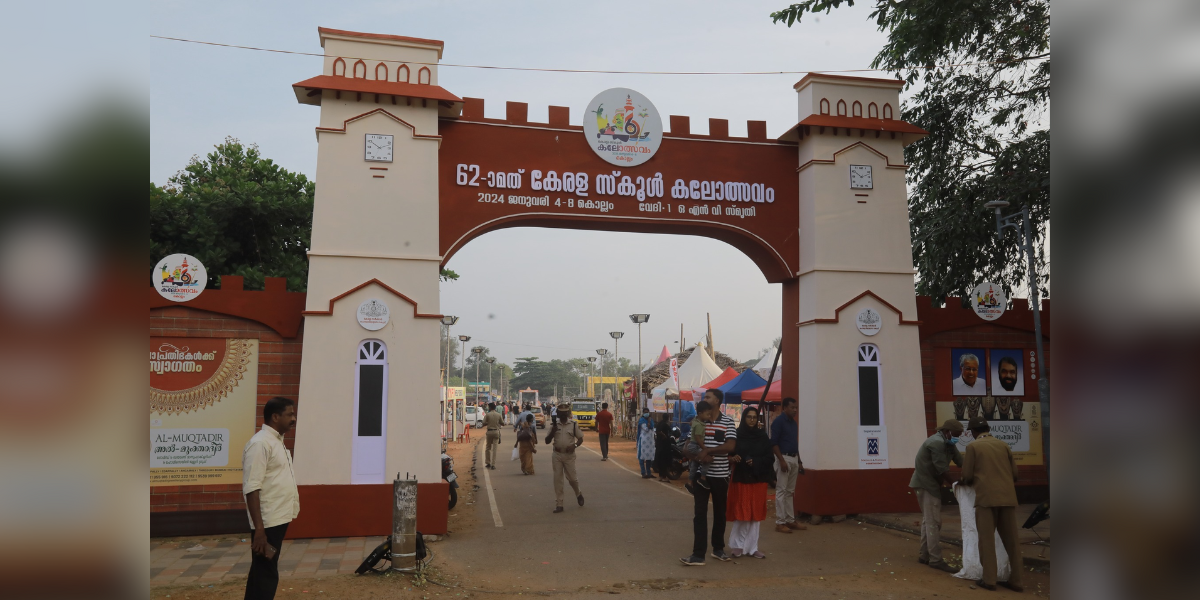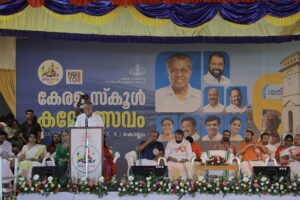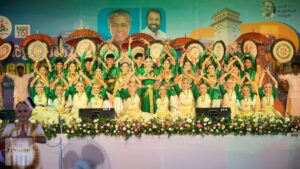Chief Minister Pinarayi Vijayan inaugurated the festival in Kollam before a packed audience of participants, parents, and art enthusiasts.

Main entrance of the school festival. (Supplied)
The 62nd edition of Kerala State School Kalolsavam, the largest-of-its-kind student festival in Asia, got off to a colourful start at Kollam on Thursday, 4 January, with Chief Minister Pinarayi Vijayan lighting the traditional lamp to mark its beginning before a packed audience of talented students, their parents, and art appreciators in general.
Over 14,000 students will compete for laurels in the five-day-long festival, which will be held simultaneously in 239 disciplines in two categories — high school and higher secondary — at 24 different venues.
In his inaugural speech, Vijayan said that the festival reflects changing times and the unity and cross-cultural relations among the people of different geographical locations in the state. The chief minister urged students and parents not to view school youth festivals merely as occasions for competition and winning points, emphasising that they should serve as venues to hone children’s artistic skills and develop their personalities.

Pinarayi Vijayan inaugurating the five-day festival. (Supplied)
Vijayan also highlighted the importance of children’s participation, urging parents not to consider it a competition but rather a festival for children. He encouraged self-reflection on how many children, triumphant in youth festivals, pursue their artistic talents further in life.
He advocated using art to raise awareness among children about the perils of alcohol and drugs. Stressing the significance of alerting children to the dangers of modern technologies and gadgets, the chief minister highlighted the potential of art in this regard.
Kerala’s General Education Minister V Sivankutty, Finance Minister KN Balagopal, Transport Minister KB Ganesh Kumar, actors Asha Sharath and Nikhila Vimal, and senior officials and educationists were present at the inaugural ceremony.
Sivankutty told South First that his department has inquired across Asia and found no such art festival for secondary and senior secondary children on such a large scale. He also noted that cultural gatherings of this size are rare worldwide.
He stated that the School Kalolsavam has been a platform for many notable artists and cultural figures, except for the two years during the Coronavirus-induced lockdown.
Many entered the entertainment industry through the Kalolsavam. This list includes Kalolsavam winners who were successful in many fields.
Kalolsavam has greatly benefited the Malayalam cinema industry by introducing talented individuals. The festival launched several cinematic careers for actors and singers. Manju Warrier, Malayalam cinema’s most famous female actor, appears on the list. Warrier won Kalathilakam (Best Female Performer) in 1992 and 1995.
Three decades ago, Guinness Pakru and Malayalam actor Ajay Kumar missed the Kalaprathibha (Best Male Performer) at the Tirur Kalolsavam.
Pakru’s Kalolsavam fancy dress debut could have been more memorable. He became a Kalolsavam star after adding kathaprasangam, mono-act, and imitation to his repertoire. Pakru’s nickname comes from his Guinness World Record as the tiniest character actor in a feature film.
Both Vineeth, who won the Kalaprathibha in 1986, and Divya Unni, who won the Kalathilakam in 1990 and 1991, grew from the festival. Other actors include Navya Nair, Kavya Madhavan, and Vindhuja Menon.

From the inaugural of the Kerala State School Kalolsavam. (Supplied)
Malayalis still remember the 2001 newspaper photo of Navya crying after losing the Kalathilakam crown to Ambili Devi. Navya was Kalathilakam in Alappuzha Kalolsavam that year.
Vineeth became famous in the 1980s for his Bharatanatyam performances. He was the champion for four years in a row.
Famous singer KJ Yesudas won the Kalolsavam, which may surprise some. Vineeth Sreenivasan, a playback singer-turned-actor and director, competed in Mappilappattu in 2000.
Legendary playback singer KS Chithra is another major star. The 1978 singing contest awarded her first place. The school Kalolsavam included veteran singer P Jayachandran.
Many politicians competed in the Kalolsavam, not just in elocution but also in many other competitions.
In 1992, Minister for Health and Family Welfare Veena George received the Tirur Kalolsavam prize for her mono-act. After Yudhishthira pawned Panchali in a dice game with Shakuni, she acted out her distress at Kaurava’s court. In the previous year, Veena, a student at Mount Bethany English Medium Higher Secondary School in Mylapra, Pathanamthitta, performed the meeting between Kunthi and Karnan before the Mahabharata battle. This performance won her second prize the 1991 Kasaragod Kalolsavam.
Early festival memories include a single site and a large dining hall, supervised by renowned chef Pazhayidom Mohanan Namboothiri, who fed the participants, parents, and teachers.
The inaugural celebration was conducted in 1957, shortly after the state’s first elected government took office. At that time, providing food to participants still needed to be addressed. Numerous kids complained about attending events on an empty stomach.
The next year, festival planners began providing food at nearby restaurants and distributing coupons to qualifying students and instructors. Those travelling great distances received ₹1 as meal allowance. A small transportation allowance was also provided to get them to the festival venue.
At this year’s event in Kollam, 17,000 people are being fed meals daily. Despite the mythical King Nalan’s culinary skills, authorities say it would take a lot of work to satisfy teachers, students, and parents from across the state.
The idea of an arts festival in Kerala originated from the then-director of education, CS Venkiteswaran, who witnessed a similar festival for college students in Delhi. A special meeting was held in November 1957 for this purpose.
All schools were advised of an upcoming arts event to promote talented students and were asked to identify potential participants. December arts festivals in all districts allowed champions to participate again at the state level.
Originally planned to be held at Model School, Thiruvananthapuram, in 1957, the first school arts festival was relocated to Ernakulam at the last minute. Competitions were held in Ernakulam girls’ school halls, with accommodations in nearby schools.
Including 60 girls, 400 students competed in 18 competitions across 13 categories that year.
The second festival took place at the Government Girls’ Model School in Thiruvananthapuram under the supervision of then-education minister Joseph Mundassery.
Yesudas and Jayachandran received singing and Mridangam prizes at this festival. They became state-famous playback singers. Over 600 participants attended that festival.
Even then, feeding students was difficult. However, a lavish feast was hosted during the 1962 Changanassery festival. In that year, only first-place winners were eligible for the state festival.
The 1964 Thiruvalla festival drew large crowds. Previously, only officials made decisions about event organisation, but this year, the public was included in the committees. In that year, All India Radio broadcast great artistic performances to the public. Attendance at the site was higher for theatre competitions than for dance performances. There was no festival in 1966.
Palakkad hosted the cheapest festival. The ninth festival in Shoranur was held for three days for just ₹10,250. Festival expenses amounted to lakhs of rupees in the 1990s. Today, spending exceeds ₹1 crore.
Ministers began attending festival opening and closing ceremonies in 1968. In that year, the site was Thrissur.
Then education minister CH Mohammed Koya opened the festival and chief minister EMS Namboodiripad distributed the prizes at the concluding ceremony.
The first festival memento was published that year. Various literary figures contributed to it, including G Sankara Kurup, Uroob, ONV, and Basheer.
The event changed drastically throughout the 1970s. In that decade, the festival was first hosted in Irinjalakuda under a large pandal. Ummar Padappa, a Cheruthuruthi native, created a pandal accommodating 7,000 people.
In 1971, a festival song was performed and broadcast on All India Radio, winning awards. The 1976 Kozhikode festival saw a big procession. K Karunakaran, then home minister, led the march from Mananchira Maidan to Zamorin’s High School in Kozhikode.
Telephones were provided for the 1977 festival. In 1978, the festival entered history with the first events held at four venues.
Kalaprathibha and Kalathilakam, top prizes for boys and girls, were introduced at the 1986 Thrissur festival. Leading Malayalam poet Chemmanam Chacko nominated the winners.
The first winners were R Vineeth of Kannur and Ponnambili of Kollam. Later, they gained fame in movies.
These honours were discontinued in 2005 during the Tirur festival due to unhealthy competition. Athira R Nath won last.
Thrissur-born Aparna K Sharma became Kalathilakam after a court ruling. She had to wait a year to receive this honour. Grading was established in 2006 to reduce unhealthy rivalry.
Mahakavi Vyloppilli Sreedhara Menon, a judge at the 1985 Ernakulam festival, proposed a Golden Cup. The following celebration took place in Thrissur, known for its gold trading.
Despite the then-education minister, TM Jacob, inviting gold traders to collect precious metal for the cup, only 20 sovereigns were collected instead of the desired 101 sovereigns. Jacob was dejected and settled for a gold-plated cup.
At the 1987 Kozhikode festival, Jacob’s anguish faded. Chirayinkeezhu Sreekandan Nair made a gold cup with 117.5 sovereigns collected from students and teachers.

Jul 26, 2024

Jul 26, 2024

Jul 25, 2024

Jul 25, 2024

Jul 25, 2024

Jul 24, 2024